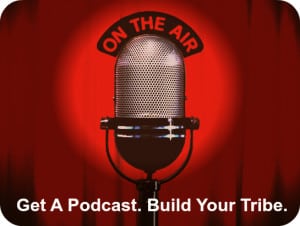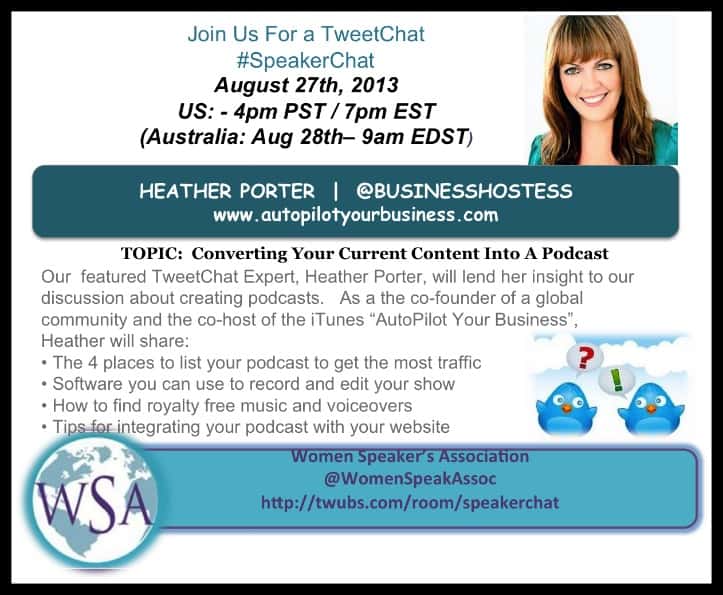
With such easy access to the equipment, software and distribution needed to launch and manage your own podcast it is no wonder smart business owners and consultants are implementing this as one of their online marketing strategies.
What is a podcast?
Podcasts are basically an ongoing show with episodes that are released in different directories online, with iTunes being one of the most popular. They are available for download to be played on mobile devices or computers. There are video podcasts but the most popular ones are currently audio.
Why are podcasts popular?
Many businesses use podcasting as a way to repurpose their other content. For example, a radio show can make their shows or a portion of their shows into a podcast, an expert can record a series of webinars and use the audio recordings as a podcast, a speaker can read their presentation into a microphone and break it into a series of shows, or a coach can turn their video ecourse into a podcast by only using the audio from the videos. The ideas are endless, but the most successful podcasts tend to either be interviews or be hosted by 2 people in a conversation style, and are released weekly.
Need help getting ideas? Head to iTunes, then podcasts, choose a category and then look under “What’s Hot”. Think of a podcast as a really easy way to reach a global audience, build a tribe of followers and share recent content to people who have set aside some time to be focused only on you. With commute times and airline commutes on the rise so are podcasts. Plus you have an engaged audience who have planned to set aside that time to only listen to you!
What do you need to start a podcast?
1. Equipment
You need a microphone that plugs into your computer. I have found some of the Logitech headphones to be great. I used the Logitech USB Headset H390 (http://www.logitech.com/en-us/product/stereo-headset-h390) for my podcast shows before it broke. Now I use the Blue Yeti (http://bluemic.com/yeti/).
2. Software
I use 2 pieces of software. I use a Skype call recorder for interviews I conduct or when it is only my co-host and I. The ecamm recorder is great for mac (http://www.ecamm.com/mac/callrecorder/) and Vod Burner is a good one for a PC (http://www.vodburner.com/). They allow you to record either audio or video (should you wish to enable your webcam). Once I record the show I do some light editing in a free program called Audacity (http://audacity.sourceforge.net/). Sure there are more superior ones out there, but this is perfect for when you are just getting started, and I still use it now. It allows you to edit on your bumpers (intro and outros) and easily delete any mess-ups with a click and drag of your mouse.
3. Distribution
There are dozens of places you can publish your podcast but I love to use a WordPress plugin called Blubrry (http://www.blubrry.com/). It allows you to easily link to iTunes and automates your posting so that each time you create a blog post and enter your MP3 into the plugin as part of that post it automatically also posts it into your iTunes podcast channel. It also allows you to use keywords throughout for ease of promotion. Talk about repurposing! Your blog post is both a post and the show notes, or description, in iTunes. I choose to store my audio files in Amazon S3 and this plugin also allows you to link easily to that account. The exciting thing is that once you have a podcast you can post it in many places online.
Remember, leveraging your marketing by using platforms that already have traffic is incredibly powerful. After all isn’t this why we use social media for business? If you are an author, speaker or expert you definitely have a message the world needs to hear. Podcasting and getting instant access to the millions of iTunes users is a natural next step.
Please join us for the next #SpeakerChat
August 27th at 4pm PST/7pm EST
Follow along and join the conversation at www.twubs.com/speakerchat


Something your readers might like is to get a better sound and save some money, get and audio-technica ATR-2100 it is a USB/XLR mic that has excellent pickup without the echo of condensor mics like Blue. These miss are only 35 dollars over at Amazon.
Also Amazon S3 sounds like a goo inexpensive deal that is till you start to get popular and it can easily ramp up to over 300/ month which isn’t a good deal, and you then have the headache of moving your back library to libsyn.com or blubrry.com
Other than that you have sound information and you have done a good job on the presentation. Can’t wait to hear you tomorrow.
Hey thanks for the added info Bryan, especially about the mic.